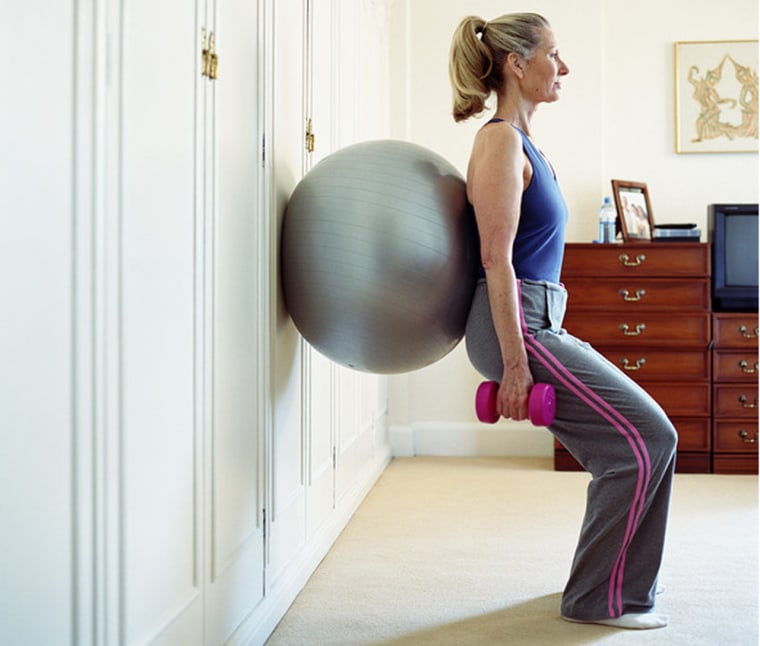What are some cost-cutting ways to work out? Just what is a side stitch — and what can you do to fix it? Smart Fitness answers your queries. Have an exercise question? To e-mail us, . We’ll post select answers in future columns.
Q: What are some cheap ways to stay in shape and get my body toned?
A: Sounds like you're balking at pricey gym memberships. True, some clubs charge well over $100 a month, making them affordable to only the wealthiest gym rats.
But the average health club membership in the United States is just $35 a month, according to Brooke Correia, a spokesperson for the International Health, Racquet and Sportsclub Association, based in Boston.
A little more than a dollar a day isn't so bad if you view that money as an investment in your health — exercise can help stave off heart disease, diabetes and other costly ills. But membership fees are money down the drain if you don't use the club regularly. And once you sign up, you're usually locked into at least a one-year agreement.
To curb costs, shop around for a basic gym without the frills. Fancy clubs with expansive workout rooms, spas, pools, juice bars and other high-end amenities come with fancy fees. Also find out whether the gyms you're checking out offer month-to-month memberships, suggests Correia. That way, if you don't like a gym, it turns out to be too inconvenient to get to during rush hour, or your job sends you to the Shanghai office for three months, you're not stuck.
If you're considering signing up for a year membership or longer, ask about specials and carefully do the math when the recruiter makes your head spin with plans A, B, C and D. One plan may involve a higher sign-up fee but have lower monthly payments. Another may waive the sign-up fee but have higher monthly payments. The former is probably the better choice over the long term, but try to estimate how long you'll be a member and then get out your calculator to crunch the numbers.
And when gyms offer different pricing plans, don't sign up on the spot. Give the recruiter a week or so to determine if there are any "new" specials that just may earn your business.
Buddy up
Another way to save money at the gym is to buddy up with a partner or two for personal training.
Though it might seem to take the "personal" out of personal training, consider that a trainer's eyes really don't need to be fixed on you every second. The trainer can give your partner guidance while you're doing your three sets of crunches, and then come back to you while your partner is stretching. In some cases, you and your partner may follow the same routine and still get ample attention.
To really save a bundle of money, exercise at home, advises Mike Bracko, a spokesperson for the American College of Sports Medicine who works as exercise physiologist and fitness consultant in Calgary, Alberta, Canada.
"I think people have the misconception that in order to get in shape you have to go to a gym, and that's not true," he says.
Walking or jogging around the neighborhood, playing basketball with your buddies or doing calisthenics in front of the TV are practically free.
And buying home exercise equipment, while a big upfront expense, can be cheaper in the long run than paying a gym membership. A good quality treadmill might run you $800 to $1,000, Bracko says, while a sturdy home weight-training gym can be had for $1,000 to $1,500.
Other suggestions for your home workout room: a $20 to $30 exercise ball and an instruction book with ideas on the many ways to use it, a couple of $10 to $20 sets of hand weights, a few $10 or $15 workout videos and some cheap rubber exercise tubing.
Exercising at home has other benefits: You can keep an eye on the kids, watch your favorite TV shows and avoid traffic.
"You can do it on your time," Bracko says. "The health club is right there."
Q: I sometimes get that pain on the right side of my abdomen when I run. It feels like it's under my ribs. What is it? And how can I avoid it?
A: It's a side stitch, and it can plague both novice and veteran runners, says Paul Greer, an exercise science specialist and coach of the San Diego Track Club.
Researchers believe a side stitch is caused by a spasm in the diaphragm brought on by stretching of the ligaments that connect the diaphragm to other organs. Pounding the pavement can stretch these ligaments.
So what should you do when you get that sharp pain under your ribcage?
If it's on the right side, says Greer, slow down and exhale forcefully each time your left foot hits the ground. If the pain is on the left, exhale when your right foot touches down.
If that doesn't work, he says, try jogging with your hands on top of your head and your elbows back — to stretch — while you breathe deeply. It might also help to put your fist under your ribcage and hold it there for a few seconds while you breathe.
"If nothing else helps, just stop and walk until the pain subsides," says Greer.
To prevent side stitches, avoid eating an hour before you run, which seems to bring on stitches, and try to breathe normally, he says.
"The key is to stay relaxed," he says. "Just breathe."
Smart Fitness appears every other Tuesday.
